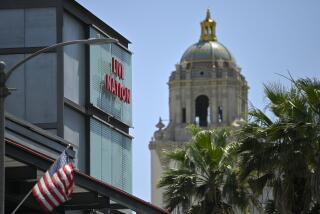Review: Marius Bercea at Francois Ghebaly Gallery
- Share via
Fourteen recent paintings by Romanian artist Marius Bercea are filled with languorous beauty, negotiating a conflicted intersection between sincere, profound yearning and deep psychological distress.
This is Bercea’s third solo show at Francois Ghebaly Gallery and his most impressively resolved. Form and content merge in one of the year’s most affecting gallery exhibitions.
Born in the Transylvanian city of Cluj-Napoca, where he still lives and works, Bercea, 37, grew up during tumultuous times. He experienced childhood during a grinding era of severe austerity, when four decades of Utopian Communism crashed on the rocks of cruel reality. Following the 1989 revolution – a blood-spattered episode in the political, social and cultural collapse of Eastern Europe, which elsewhere simply tipped over and shattered – the upheaval culminated in the hasty trial and sudden execution of brutal dictator Nicolae Ceaușescu.
Nowhere in Bercea’s new paintings are these events depicted. He instead represents a sulfurous yet tenaciously poignant world – a kind of post-expulsion Eden, which could as easily be 21st century Caracas or Beijing, Los Angeles or Johannesburg.
“Fellow Biologists” is emblematic. Two serene, bikini-clad women float face-down on inflatable rafts in a large indoor swimming pool. The once-modern, now-crumbling glass-walled natatorium overflows with tropical plants – dense, untidy and somehow too lush.
It’s all vaguely threatening, the failed modernity even somehow sinister.
Tall palms and spiky dracaena look like aerial explosions. The pool’s water glows an unnerving blue. Through the windows, a luminous sunset sky blazes in purples and acrid chlorophyll green.
The ensemble is like a pleasurable public recreation hall crossed with the melting core of a nuclear reactor, the local Y as Chernobyl.
Bercea puts himself squarely among the “fellow biologists” of his painting’s title, studying living organisms in their environment. His painterly technique, marvelously well-handled, carries the complex visual motif.
Alternately extravagant in their plush brushwork and scraped dry across the canvas tooth, thinned acrylics coexist with thick, moist oil paint and vaporous aerosol spray. The pigments refuse to harmoniously mix, all while layering to evoke the ancient encrustations of ruined walls. The beautiful discord, beguiling and bleak, is what it is and always has been.
Most of the paintings are large (“Fellow Biologists” is about 6 feet by 5 feet) and of a scale relatively standard in the contemporary repertoire for engaging a viewer’s bodily senses. That means a bit taller than the average person and just wider than outstretched arms.
But even Bercea’s small works carry heft.
A small, simple floral still-life sets the lance-shaped, yellow-edged green leaves of an upright sansevieria, colloquially known as snake plant or mother-in-law’s tongue, against a dense, horizontally scraped background of mottled grays. Visually, the grim background abstraction demands the same attention as the airless foreground. The plant is both fierce pictorial protagonist and toxic warrior.
You don’t need to know the plant’s reputation as an antiseptic home remedy to see its lovely endurance amid a wholly leaden environment. Bercea, as he does throughout this memorable show, balances one against the other in a lithe display of utterly routine determination.
Francois Ghebaly Gallery, 2245 E. Washington Blvd., (323) 282-5187, through May 14. Closed Sun. and Mon. www.ghebaly.com
christopher.knight@latimes.com
Follow me @KnightLAT
More to Read
The biggest entertainment stories
Get our big stories about Hollywood, film, television, music, arts, culture and more right in your inbox as soon as they publish.
You may occasionally receive promotional content from the Los Angeles Times.











